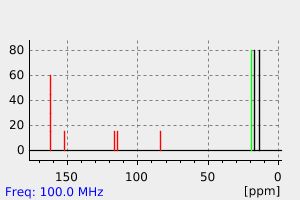5-ethyl-2,6-dihydroxy-4-methyl-nicotinonitrile | 39621-05-1
中文名称
——
中文别名
——
英文名称
5-ethyl-2,6-dihydroxy-4-methyl-nicotinonitrile
英文别名
5-Aethyl-2,6-dihydroxy-4-methyl-nicotinonitril;2,6-Dihydroxy-5-ethyl-4-methylnicotinonitril;5-ethyl-6-hydroxy-4-methyl-2-oxo-1H-pyridine-3-carbonitrile
CAS
39621-05-1
化学式
C9H10N2O2
mdl
——
分子量
178.191
InChiKey
PEIIEYSAKQLFMZ-UHFFFAOYSA-N
BEILSTEIN
——
EINECS
——
-
物化性质
-
计算性质
-
ADMET
-
安全信息
-
SDS
-
制备方法与用途
-
上下游信息
-
文献信息
-
表征谱图
-
同类化合物
-
相关功能分类
-
相关结构分类
物化性质
-
沸点:334.7±42.0 °C(Predicted)
-
密度:1.26±0.1 g/cm3(Predicted)
计算性质
-
辛醇/水分配系数(LogP):0.3
-
重原子数:13
-
可旋转键数:1
-
环数:1.0
-
sp3杂化的碳原子比例:0.33
-
拓扑面积:73.1
-
氢给体数:2
-
氢受体数:3
上下游信息
-
下游产品
中文名称 英文名称 CAS号 化学式 分子量 —— 3-cyano-2,6-dimethoxy-5-ethyl-4-methylpyridine 252950-80-4 C11H14N2O2 206.244
反应信息
-
作为反应物:参考文献:名称:Govindachari et al., Journal of the Chemical Society, 1957, p. 545摘要:DOI:
-
作为产物:描述:氰乙酰胺 、 2-乙基乙酰乙酸乙酯 在 potassium hydroxide 作用下, 以 甲醇 为溶剂, 反应 16.0h, 以47%的产率得到5-ethyl-2,6-dihydroxy-4-methyl-nicotinonitrile参考文献:名称:Design of Novel Potent Inhibitors of Human Uridine Phosphorylase-1: Synthesis, Inhibition Studies, Thermodynamics, and in Vitro Influence on 5-Fluorouracil Cytotoxicity摘要:Uridine (Urd) is a promising biochemical modulator to reduce host toxicity caused by 5-fluorouracil (5-FU) without impairing its antitumor activity. Elevated doses of Urd are required to achieve a protective effect against 5-FU toxicity, but exogenous administration of Urd is not well-tolerated. Selective inhibitors of human uridine phosphorylase (hUP) have been proposed as a strategy to increase Urd levels. We describe synthesis and characterization of a new class of ligands that inhibit hUP type 1 (hUP1). The design of ligands was based on a possible S(N)1 catalytic mechanism and as mimics of the carbocation in the transition state of hUP1. The kinetic and thermodynamic profiles showed that the ligands here presented are the most potent in vitro hUP1 inhibitors developed to date. In addition, a lead compound improved the antiproliferative effects of 5-FU on colon cancer cells, accompanied by a reduction of in vitro 5-FU cytotoxicity in aggressive SW-620 cancer cells.DOI:10.1021/jm401389u
文献信息
-
Reactive dye composition申请人:SUMITOMO CHEMICAL COMPANY, LIMITED公开号:EP0127456A2公开(公告)日:1984-12-05A reactive dye composition comprising (1) a dye having the formula, wherein D is an organic dye residue having at least one sulfo group, R, and R2 are independently a hydrogen atom or an unsubstitute or substituted lower alkyl group, A is an unsubstituted or substituted phenylene or naphthylene group, X is a halogen atom, and Y is a group, -S02CH=CH2 or -S02CH2CH2Z, in which Z is a group capable of being split by the action of an alkali, and (2) a buffer, the amount of the buffer being from 3 through 80% by weight based on the weight of the dye, and the pH value of an aqueous solution prepared from the dye composition and water of 20 times as much as the weight of the dye composition being from 3.5 through 7.5, which is superior in storage stability, and useful for dyeing or printing fiber materials to give dyed or printed products having superior fastness with high reproducibility.
-
On the methylation of 3-cyano-6-hydroxypyridine-2(1H)-ones作者:Yves Louis Janin、Jaouad Chiki、Michel Legraverend、Christiane Huel、Emile BisagniDOI:10.1016/s0040-4020(99)00755-3日期:1999.10In order to prepare new heterocyclic derivatives as building block for compounds with potential biological activities, we were led to study the O-methylation of 3-cyano-6-hydroxypyridine-2(1H)-ones such as 1. This enabled us to develop a new two steps method to prepare the corresponding 2,6-dimethoxy derivative 5 in 80 % yield. It consisted first in heating 1 in trimethylorthoformate, with or without an acidic catalyst, which gave a mixture of the two mono-methoxy isomers, then a classical methylation of the second hydroxy moiety led almost exclusively to 5. In this paper we present this "methylation" method and various unexpected results recorded when we attempted to extend it to related derivatives or to other heterocycle containing lactim-lactam functions. An intramolecular transetherification mechanism requiring the simultaneous transfer of a hydrogen and a methyl is suggested. (C) 1999 Elsevier Science Ltd. All rights reserved.
-
Gibson; Simonsen, Journal of the Chemical Society, 1929, p. 1075作者:Gibson、SimonsenDOI:——日期:——
-
Guareschi, Chemische Berichte, 29 Ref. <1896>, 656作者:GuareschiDOI:——日期:——
-
Guareschi, vol. <2> 57, p. 297作者:GuareschiDOI:——日期:——
表征谱图
-
氢谱1HNMR
-
质谱MS
-
碳谱13CNMR
-
红外IR
-
拉曼Raman
-
峰位数据
-
峰位匹配
-
表征信息
同类化合物
(S)-氨氯地平-d4
(R,S)-可替宁N-氧化物-甲基-d3
(R)-(+)-2,2'',6,6''-四甲氧基-4,4''-双(二苯基膦基)-3,3''-联吡啶(1,5-环辛二烯)铑(I)四氟硼酸盐
(R)-N'-亚硝基尼古丁
(R)-DRF053二盐酸盐
(5E)-5-[(2,5-二甲基-1-吡啶-3-基-吡咯-3-基)亚甲基]-2-亚磺酰基-1,3-噻唑烷-4-酮
(5-溴-3-吡啶基)[4-(1-吡咯烷基)-1-哌啶基]甲酮
(5-氨基-6-氰基-7-甲基[1,2]噻唑并[4,5-b]吡啶-3-甲酰胺)
(2S,2'S)-(-)-[N,N'-双(2-吡啶基甲基]-2,2'-联吡咯烷双(乙腈)铁(II)六氟锑酸盐
(2S)-2-[[[9-丙-2-基-6-[(4-吡啶-2-基苯基)甲基氨基]嘌呤-2-基]氨基]丁-1-醇
(2R,2''R)-(+)-[N,N''-双(2-吡啶基甲基)]-2,2''-联吡咯烷四盐酸盐
(1'R,2'S)-尼古丁1,1'-Di-N-氧化物
黄色素-37
麦斯明-D4
麦司明
麝香吡啶
鲁非罗尼
鲁卡他胺
高氯酸N-甲基甲基吡啶正离子
高氯酸,吡啶
高奎宁酸
马来酸溴苯那敏
马来酸氯苯那敏-D6
马来酸左氨氯地平
顺式-双(异硫氰基)(2,2'-联吡啶基-4,4'-二羧基)(4,4'-二-壬基-2'-联吡啶基)钌(II)
顺式-二氯二(4-氯吡啶)铂
顺式-二(2,2'-联吡啶)二氯铬氯化物
顺式-1-(4-甲氧基苄基)-3-羟基-5-(3-吡啶)-2-吡咯烷酮
顺-双(2,2-二吡啶)二氯化钌(II) 水合物
顺-双(2,2'-二吡啶基)二氯化钌(II)二水合物
顺-二氯二(吡啶)铂(II)
顺-二(2,2'-联吡啶)二氯化钌(II)二水合物
韦德伊斯试剂
非那吡啶
非洛地平杂质C
非洛地平
非戈替尼
非布索坦杂质66
非尼拉朵
非尼拉敏
雷索替丁
阿雷地平
阿瑞洛莫
阿扎那韦中间体
阿培利司N-6
阿伐曲波帕杂质40
间硝苯地平
间-硝苯地平
镉,二碘四(4-甲基吡啶)-
锌,二溴二[4-吡啶羧硫代酸(2-吡啶基亚甲基)酰肼]-







